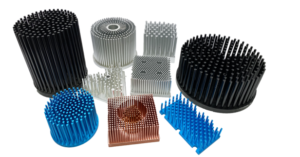
Home / Newsletter / 90. Cold Forged Heat Sink for Automotive Industry
90. Cold Forged Heat Sink for Automotive Industry
Cold forging is adopted increasingly in the automotive industry for its exceptional heat dissipation capabilities.
OCT 29, 2023
Cold forging is adopted increasingly in the automotive industry for its exceptional heat dissipation capabilities. Common cold-forged parts in the automotive sector include gears, shafts, bearings, suspension parts, inverters, brake component fasteners, etc. Why cold forging manufacturing process?
Cold Forging is a process that metal is shaped and formed into desired shapes under great pressure and at room temperature, with one single punch, the 3-dimensional heat sink emerges. It generates no heat or energy loss, reduces the need for secondary processes, and lessens material loss. Cold-Forging heat sinks offer accurate dimensions, strong surfaces and reliable structure, making it an attractive choice for many automotive applications.
👓 Watch cold forging manufacturing process
Cold Forging Advantages
1. Material Strength: Cold forging typically works with materials like AL1050,1060,1070,6063,6061 and CU1100; these materials can be effectively shaped and deformed at room temperature without compromising their structural integrity and offering cold forged heat sinks with high strength and durability.
2. Precision dimension: The controlled deformation and lower temperatures help maintain the shape and size of the part
3. Cost-Effective: This manufacturing process minimizes material waste and has higher production rate.
4. Enhanced Surface Finish: The metal is shaped and formed into desired shapes under high pressure; this compression results in a denser and smoother surface.
5. Environmentally Friendly : Minimum material waste and reduced energy consumption of this process are aligned with eco-friendly practice in automotive industry.





